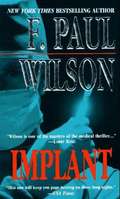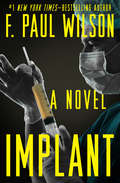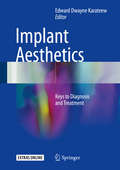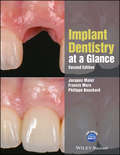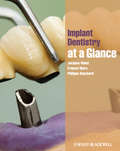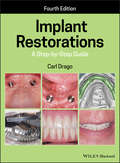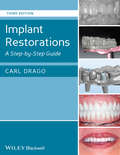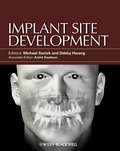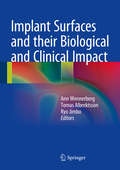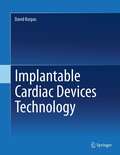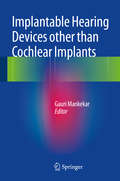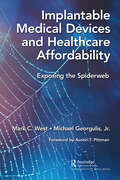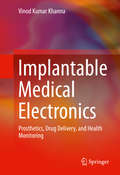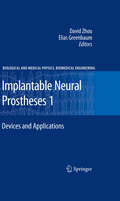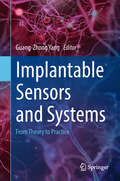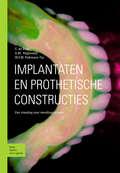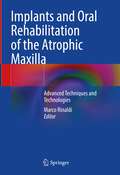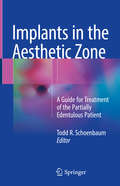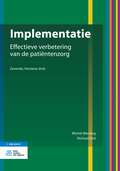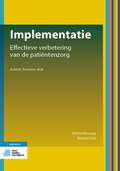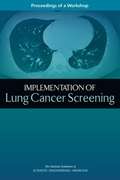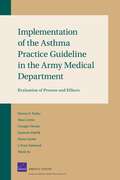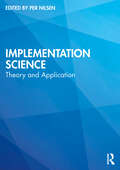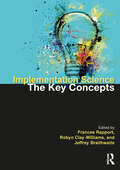- Table View
- List View
Implant: A Novel (Thriller Ser.)
by F. Paul WilsonThe New York Times–bestselling author of The Select is “one of the masters of the medical thriller and this one will keep you page-turning” (Larry King, USA Today). Dr. Duncan Lathram is a brilliant plastic surgeon who recently invented a dissolving implant that allows incisions to heal without scarring. His unparalleled artistry in the operating room is the salvation of all the biggest power players in Washington, DC, whenever they need to be TV ready. Lathram appears to have it all, but something isn’t right . . . When young Gina Panzella isn’t hustling as a house doctor at a local community hospital, she assists Dr. Lathram with surgery. She’s known him almost her entire life and respects him deeply, yet there are a few things about him she can’t quite figure out—like why so many of his patients are mysteriously dying. Overcome with suspicion and fear, Panzella enlists the help of Gerry Canney, a high school classmate now working with the FBI, to dig deep into the doctor’s past. Soon they will discover what Lathram is truly capable of . . .
Implant Aesthetics: Keys to Diagnosis and Treatment
by Edward Dwayne KarateewThis book, written by acknowledged experts with international reputations, provides clinicians with detailed guidelines on the nature of the ideal anterior dental implant and, more importantly, how the desired aesthetic outcome is to be achieved. It reflects the incredible paradigm shift that has taken place within implant dentistry during the past 5 years, with recognition of the importance of a 'crown down' approach to diagnosis, planning, and treatment, especially in the anterior zone. In order to ensure reproducibility and predictability of treatment outcomes, the fabrication of an aesthetic dental implant must follow a complex algorithm, which is reviewed in a stepwise approach. Sections are devoted to evaluation of the aesthetic implant patient, immediate implant placement, staged implant placement, and restoration. Readers will come to appreciate how the final emergence profile of the definitive restoration reflects the complex interplay of components below the visible smile zone. Helpful flow charts are included that will assist in optimal performance of the described procedures.
Implant Dentistry at a Glance (At a Glance (Dentistry) #60)
by Jacques Malet Francis Mora Philippe BouchardThe second edition of Implant Dentistry at a Glance, in the highly popular at a Glance series, provides an accessible, thoroughly revised and updated comprehensive introduction that covers all the essential sub-topics that comprise implant dentistry. Features an easy-to-use double-page spread, with text and corresponding images Expanded and updated throughout, with 13 new chapters and coverage of many advances Includes access to a companion website with self-assessment questions and illustrative case studies
Implant Dentistry at a Glance (At a Glance #60)
by Jacques Malet Francis Mora Philippe BouchardThis title in the highly popular at a Glance series provides a concise and accessible introduction and revision aid, comprehensively covering all the constituent sub-topics that comprise implant dentistry. Following the familiar, easy-to-use at a Glance format, each topic is presented as a double-page spread with facts accompanied by clear diagrams and clinical photographs encapsulating essential information. Implant Dentistry at a Glance is an ideal companion for all students of dentistry, junior clinicians and members of the dental team with an interest in implant dentistry.
Implant Restorations: A Step-by-Step Guide
by Carl DragoThe fourth edition of Implant Restorations: A Step-by-Step Guide provides a wealth of updated and expanded coverage on detailed procedures for restoring dental implants. Focusing on the most common treatment scenarios, it offers concise literature reviews for each chapter abd easy-to-follow descriptions of the techniques, along with high-quality clinical photographs demonstrating each step. Comprehensive throughout, this practical guide begins with introductory information on incorporating implant restorative dentistry in clinical practice. It covers diagnosis and treatment planning and digital dentistry, and addresses advances in cone beam computerized tomography (CBCT), treatment planning software, computer generated surgical guides, rapid prototype printing and impression-less implant restorative treatments, intra-oral scanning, laser sintering, and printing/milling polymer materials. Record-keeping, patient compliance, hygiene regimes, and follow-up are also covered. Provides an accessible step-by-step guide to commonly encountered treatment scenarios, describing procedures and techniques in an easy-to-follow, highly illustrated format Offers new chapters on diagnosis and treatment planning and digital dentistry Covers advances in cone beam computerized tomography (CBCT), computer generated surgical guides, intra-oral scanning, laser sintering, and more An excellent and accessible guide on a burgeoning subject in modern dental practice by one of its most experienced clinicians, Implant Restorations: A Step-by-Step Guide, Fourth Edition will appeal to prosthodontists, general dentists, implant surgeons, dental students, dental assistants, hygienists, and dental laboratory technicians.
Implant Restorations
by Carl DragoImplant Restorations: A Step-by-Step Guide, Third Edition offers clinicians a practical, step-by-step approach to treatment planning and restoring dental implants. This highly illustrated, case-based book demonstrates how to treat the most commonly encountered treatment scenarios, describing the procedures, techniques, and sequences required in clear, concise language and in an easy-to-use format. The book takes the theory of implant restoration, using as its basis 3i's implant systems, and places it directly in the operatory, concentrating in detail on each stage of the actual clinical procedures involved in treating different patients. It integrates implant treatment with the realities of running a successful restorative practice. Building on the work of the 2nd edition, the 3rd edition of this successful text reflects the advances of implant prosthetics over the intervening years, providing all new cases, exploring new techniques and technology, and demonstrating updated system components and armamentarium.Implant Restorations: A Step-by-Step Guide follows a logical structure of three sections. The first section introduces implant restorative dentistry, how to develop an implant restorative practice, the issues involved, the technical components of the 3i systems, diagnosis, and treatment planning. The central section of the book devotes separate chapters to in-depth descriptions of each of several types of patients that the restorative dentist may encounter, ranging from basic to more challenging cases. Every step of each procedure is described and illustrated with clinical photographs. Laboratory work orders are presented for use with commercial dental laboratories. The final section discusses record-keeping, patient compliance, hygiene regimes and follow-up, and provides the reader with an outline of best-practice procedural protocols.An excellent and accessible guide on the most burgeoning subject in modern dental practice by one of its most experienced clinicians, Implant Restorations: A Step-by-Step Guide, Third Edition will appeal to prosthodontists, general dentists, implant surgeons, dental students, dental laboratory technicians and dental assistants.
Implant Site Development
by Michael Sonick Debby HwangWith the desire for dental implant therapy ever escalating, clinicians are faced with the challenge of augmenting deficient natural physiology to provide effective sites for implantation. Implant Site Development helps the clinician decide if, when, and how to create a ridge site amenable to implantation. This practical book offers solutions to many implant site preservation scenarios, discussing different treatment options, timing, a variety of materials and techniques, and their application to the clinical practice. With a unique integrated clinical approach, Implant Site Development covers a range of site development techniques.Highly illustrated, Implant Site Development presents diagrams and clinical photographs to aid with clinical judgment and will prove useful for any dental professional involved in implant therapy, from general practitioners to prosthodontists, but especially surgeons. This literature-based, yet user-friendly, reference will be indispensable to the novice or veteran clinician.
Implant Surfaces and their Biological and Clinical Impact
by Ann Wennerberg Tomas Albrektsson Ryo JimboThis book provides the reader with the knowledge required in order to understand the chemical, physical, mechanical, and topographical aspects of implant surfaces, as well as their impact on the biological response. Common ways to modify implant surfaces are described, and methods for the evaluation of surface properties are presented in an easy-to-read style. Experimental results that have contributed to surface modifications relevant for commercial available implants are presented, with emphasis on in vivo and clinical studies. While the focus is primarily on surface modifications at the micrometer and nanometer levels, alterations at the millimeter level are also covered, including thread designs and their possible influence on stress distribution. In addition, it is analyzed how surface alterations have changed the clinical long-term results for certain groups of patients.
Implantable Cardiac Devices Technology
by David KorpasDevelopment in a majority of medicine branches today is based on technological advancement. This is the case in cardiology, where medical devices designed to correct heart rhythm - pacemakers, cardioverters-defibrillators and biventricular systems - are implanted in order to help a sick heart. Medical pacing devices today are only developed and produced globally by a several producers who make different technical solutions, algorithms, system parameters etc. The book Implantable Cardiac Devices Technology is targeted at biomedical, clinical engineers, technicians in practice, students of biomedical disciplines, and all medical staff who are required to understand the basics of pacing technology. The book is comprised of fourteen chapters that are further subdivided according to specific topics. Chapters dealing with basic heart anatomy, physiology and arythmology are included for the sake of comprehensiveness. Chapters avoid the description of special functions, but cover general procedures and parameters common for the systems of all producers. The book is intended to serve as a monothematic textbook. In order to make the text comprehensible and well arranged for a reader, references to professional literature are only provided once in a respective chapter.
Implantable Hearing Devices other than Cochlear Implants
by Gauri MankekarHearing loss can vary in type ranging from conductive, mixed to sensorineural, as well as in degree from mild, moderate, severe to profound. There could also be multiple permutations and combinations like moderate mixed hearing loss or severe conductive hearing loss. In addition, the hearing loss could be unilateral or bilateral. While cochlear implants were devised for bilateral profound sensorineural hearing loss, various other devices have been invented for other types of hearing losses. Research continues to design a suitable implant which would amplify sound for patients who cannot be candidates for cochlear implants.
Implantable Medical Devices and Healthcare Affordability: Exposing the Spiderweb
by Mark C. West Michael Georgulis, Jr.The United States spends more than 17% of its GDP on healthcare, while other developed countries average 8.7% of GDP on healthcare expenditures. All this spending doesn’t equate to value, quality, or performance, however. Among 11 high-income countries, the United States healthcare industry ranked last during the past seven years in four key performance categories: administrative efficiency, access to care, equity, and healthcare outcomes. This book presents the implantable medical device (IMD) supply chain ecosystem as a microcosm of how these challenges of affordability and healthcare outcomes are created and are allowed to fester. The IMD Spiderweb, as the authors call it, is exposed as an example of how a wide range of participants—including physicians, health system CEOs, group purchasing organizations, health insurance companies, and supply chain executives—become ensnared in a web designed to benefit only one player. Health systems in the United States pay as much as six times more for some IMDs than their counterparts do in Europe, and prices for the same IMD model vary even among different U.S. hospitals. While there is a fascination with the latest and greatest device, there is also a shroud around visibility into how these products have performed and are likely to perform in patients. The costs continue to rise not only in healthcare expenditures, but also in death and disability. The IMD Spiderweb is presented as a prime lesson in the challenges in healthcare affordability and outcomes that occur throughout the entire healthcare industry. It is also put forward as an opportunity. The story behind how these challenges arose and continue to be deepened by the current healthcare ecosystem also provides a foundation for solutions.
Implantable Medical Electronics
by Vinod Kumar KhannaThis book is a comprehensive, interdisciplinary resource for the latest information on implantable medical devices, and is intended for graduate students studying electrical engineering, electronic instrumentation, and biomedical engineering. It is also appropriate for academic researchers, professional engineers, practicing doctors, and paramedical staff. Divided into two sections on Basic Concepts and Principles, and Applications, the first section provides an all-embracing perspective of the electronics background necessary for this work. The second section deals with pacing techniques used for the heart, brain, spinal cord, and the network of nerves that interlink the brain and spinal cord with the major organs, including ear and eye prostheses. The four main offshoots of implantable electronics, which this book discusses, are: The insertion of an implantable neural amplifier for accurate recording of neural signals for neuroengineering studies The use of implantable pulse generators for pacing the activities of diseased organs The use of implantable sensors for observing the influence of therapy and monitoring a patient's biological parameters The use of drug delivery systems to supervise the supply of accurate doses of medicine to affected parts Readers will also find chapters on the ess entials of clocking and timing circuits, pulse generator circuits, neural amplifiers, batteries, biomaterials and biocompatibility, and more. Unique to this book is also a chapter on cyber security and confidentiality concerns with implants. End-of-chapter questions and exercises help readers apply the content to practical use, making this an ideal book for anyone wishing to learn more about implantable devices.
Implantable Neural Prostheses 1
by David Zhou Elias GreenbaumThis book and its companion volume describe state-of-the-art advances in techniques associated with implantable neural prosthetic devices and their applications. Researchers, engineers, clinicians, students and any specialist in this field will gain a deeper understanding of the neural prosthetic techniques currently available for a wide range of biomedical applications. In part one of this two-volume sequence, Implantable Neural Prostheses 1: Devices and Applications, the focus is on implant designs and applications. Devices covered include sensory prosthetic devices such as cochlear implants, auditory midbrain implants, visual implants, spinal cord stimulators, and motor prosthetic devices including deep brain stimulators, Bions, and cardiac electro-stimulators. Readers will also understand the regulatory approval process in the U.S. and Europe for implantable medical devices.
Implantable Sensors and Systems
by Guang-Zhong YangImplantable sensing, whether used for transient or long-term monitoring of in vivo physiological, bio-electrical, bio-chemical and metabolic changes, is a rapidly advancing field of research and development. Underpinned by increasingly small, smart and energy efficient designs, they become an integral part of surgical prostheses or implants for both acute and chronic conditions, supporting optimised, context aware sensing, feedback, or stimulation with due consideration of system level impact.From sensor design, fabrication, on-node processing with application specific integrated circuits, to power optimisation, wireless data paths and security, this book provides a detailed explanation of both the theories and practical considerations of developing novel implantable sensors. Other topics covered by the book include sensor embodiment and flexible electronics, implantable optical sensors and power harvesting. Implantable Sensors and Systems – from Theory to Practice is an important reference for those working in the field of medical devices. The structure of the book is carefully prepared so that it can also be used as an introductory reference for those about to enter into this exciting research and developing field.
Implantaten en prothetische constructies: Een inleiding voor mondhygiënisten
by C. Baat G. M. Raghoebar W.F.M. Pelkmans-TijsNu behandelingen met implantaten steeds meer voorkomen, is theoretische en praktische scholing van mondhygiënisten op dit gebied een dringende behoefte.Implantaten en prothetische constructies beschrijft beknopt het hele traject van een behandeling met implantaten: van het opstellen van het behandelplan tot en met de nazorg. Uitgangspunt is de behandeling van een edentate onderkaak met een overkappingsprothese op implantaten, maar ook de bovenkaak en gedeeltelijk tandeloze kaken krijgen aandacht.Met de kennis die aan de hand van dit boek wordt opgedaan, is het mogelijk de orale weefsels en de implantaten met de daarop vervaardigde prothetische constructies onder controle te houden en patiënten met orale implantaten te begeleiden bij de benodigde zelfzorg.Deze publicatie is bestemd om mondhygiënisten de nodige basisinformatie te geven over de relevante aspecten van de orale implantologieDeze publicatie is bestemd om mondhygiënisten de nodige basisinformatie te geven over de relevante aspecten van de orale implantologie
Implantation and Early Development
by Hilary Critchley Iain Cameron Stephen SmithSuccessful implantation and early development need a union of healthy genes and an optimal uterine environment. The 48th RCOG Study Group, an international multidisciplinary expert forum, considered factors involved in preparation for implantation within the uterus, what makes a good egg and sperm and hence a good embryo. Lessons from animal models and transgenic and genomic technologies considered. The group looked at sporadic and recurrent early pregnancy loss and discussed new treatment options. Discussion also included single-embryo transfer and the developmental consequences of assisted reproduction technologies. This publication provides a valuable resource for gynaecologists, specialist nurses, embryologists, base scientists and all those with an interest in early pregnancy and development.
Implants and Oral Rehabilitation of the Atrophic Maxilla: Advanced Techniques and Technologies
by Marco RinaldiThis book covers the most suitable techniques for the rehabilitation of patients experiencing tooth loss, trauma or other situations resulting in bone atrophy. The book discusses current technologies, from diagnosis to treatment and surgery, applied to atrophic jaws using innovative tools and new PSI (patient specific implant) approaches. Oral Rehabilitation of the Atrophic Maxilla and the selection of the best treatment options for patients is one of the most difficult tasks facing the profession today. Readers will be able to solve complex problems and evaluate all available applications for patient management. Zygomatic implants, reconstructive surgery with bone grafts, post-oncologicasl and post traumatic reconstructions as well as dynamic navigation and robot assisted dental surgery are covered. The book is written by recognized experts and leaders in the field, and includes simpler techniques within the reach of many implantologists and more complex techniques that require specific surgical skills. It is relevant for, implanologist, periodontists, oral and maxillofacial surgeon, prosthodontists and every clinician treating maxillary atrophy.
Implants in the Aesthetic Zone: A Guide for Treatment of the Partially Edentulous Patient
by Todd R. SchoenbaumThis book concisely elucidates the science underlying implant treatment in the aesthetic zone in partially edentulous patients and clearly describes the techniques and protocols used by world-leading experts in the field. The book is divided into four parts that address treatment planning; site preparation (hard and soft tissue augmentation); immediate implant placement and provisional restoration; and the design, fabrication, and delivery of the definitive implant prosthesis. Complex cases of this nature present a significant challenge to even the most well informed and experienced of doctors. Implants in the Aesthetic Zone has been specifically crafted to meet all the needs of the clinician involved in their management, providing a reliable road map for interdisciplinary implant treatment in clinical practice. The authors have been carefully selected from a wide range of fields for their expertise in particular areas of implant science or treatment.
Implementatie: Effectieve verbetering van de patiëntenzorg
by Richard Grol Michel WensingDit boek helpt zorgverleners, leidinggevenden, staffunctionarissen, beleidsmakers en onderzoekers om pati#65533;ntenzorg op een effectieve manier te verbeteren. Het geeft een praktische, stapsgewijze aanpak voor de implementatie van innovatie in de gezondheidszorg, die rekening houdt met de weerbarstigheid van de praktijk. In Implementatie ligt de nadruk op het verbeteren van het handelen van artsen, verpleegkundigen, paramedici, andere zorgverleners, en de teams waarin zij werken. De pati#65533;nt staat hierbij centraal. Deze geactualiseerde uitgave geeft een toegankelijk overzicht van het wetenschappelijk onderzoek op het gebied van implementatie. Het beantwoordt bijvoorbeeld de vraag hoe het komt dat veel waardevolle inzichten, hulpmiddelen, programma's en best practices de weg naar de praktijk niet vinden. En andersom hoe het kan dat er soms werkwijzen gebruikt worden waarvan is aangetoond dat ze geen meerwaarde hebben voor pati#65533;nten of burgers. Implementatie beschrijft vele concrete voorbeelden van verandertrajecten in Nederland en daarbuiten. Bij het boek horen digitale verrijkingen, zoals samenvattingen van de hoofdstukken en toetsen met multiplechoicevragen en stellingen.
Implementatie: Effectieve verbetering van de patiëntenzorg
by Michel Wensing Richard GrolDit boek helpt zorgverleners, leidinggevenden, staffunctionarissen, beleidsmakers en onderzoekers om patiëntenzorg op een effectieve manier te verbeteren. Het geeft een praktische, stapsgewijze aanpak voor de implementatie van innovaties in de gezondheidszorg, die rekening houdt met de weerbarstigheid van de praktijk.In Implementatie ligt de nadruk op het verbeteren van het handelen van artsen, verpleegkundigen, paramedici, andere zorgverleners, en de teams waarin zij werken. De patiënt staat hierbij centraal. De uitgave geeft een toegankelijk overzicht van het wetenschappelijk onderzoek op het gebied van implementatie. Het beantwoordt bijvoorbeeld de vraag hoe het komt dat veel waardevolle inzichten, hulpmiddelen, programma’s en best practices de weg naar de praktijk niet vinden. En andersom hoe het kan dat er soms werkwijzen gebruikt worden waarvan is aangetoond dat ze geen meerwaarde hebben voor patiënten of burgers. Hierbij wordt nadruk gelegd op de rol van contextfactoren bij verbetering en implementatie. De vele concrete voorbeelden van verandertrajecten in Nederland en daarbuiten vullen dit overzicht aan.Implementatie in de zorg mag zich verheugen in een groeiende belangstelling van wetenschap en praktijk. Deze achtste editie bevat daarom veel nieuwe ontwikkelingen en actuele voorbeelden. Het boek is compacter geschreven en een aantal hoofdstukken is grondig herzien. Het resultaat is een omvattend, actueel en praktisch toepasbaar overzicht van de kennis op het gebied van verbetering van de patiëntenzorg.
Implementation of Lung Cancer Screening: Proceedings of a Workshop
by Engineering Medicine National Academies of SciencesThe public health burden from lung cancer is substantial: it is the second most commonly diagnosed cancer and the leading cause of cancer-related deaths in the United States. Given the individual and population health burden of lung cancer, especially when it is diagnosed at later stages, there has been a push to develop and implement screening strategies for early detection. However, many factors need to be considered for broad implementation of lung cancer screening in clinical practice. Effective implementation will entail understanding the balance of potential benefits and harms of lung cancer screening, defining and reaching eligible populations, addressing health disparities, and many more considerations. In recognition of the substantial challenges to developing effective lung cancer screening programs in clinical practice, the National Academies of Sciences, Engineering, and Medicine held a workshop in June 2016. At the workshop, experts described the current evidence base for lung cancer screening, the current challenges of implementation, and opportunities to overcome them. Workshop participants also explored capacity and access issues; best practices for screening programs; assessment of patient outcomes, quality, and value in lung cancer screening; and research needs that could improve implementation efforts. This publication summarizes the presentations and discussions from the workshop.
Implementation of the Asthma Practice Guideline in the Army Medical Department
by Suzanne Pieklik Donna O. Farley Elaine Quiter Shan Cretin Georges VernezIn partnership with the Army Medical Department, RAND worked to implement clinical practice guidelines. This report evaluates the asthma guideline demonstration. It documents the actions, assesses effects, and measures the quality and limitations of data for monitoring outcomes. The authors found that the implementation scored successes but resource limitations and organizational barriers curbed progress. They conclude that flexibility, monitoring, and training are the keys to implementing the guidelines. They also found that patient education needed improvement.
Implementation Science: Theory and Application
by Per NilsenThis core textbook introduces the key concepts, theories, models and frameworks used in implementation science, and supports readers applying them in research projects. The first part of the book focuses on the theory of implementation science, providing a discussion of its emergence from the evidence-based practice movement and its connections to related topics such as innovation research. It includes chapters looking at a wide range of theories, methods and frameworks currently used in implementation science, and a chapter focusing on suitable theories that could be imported from other fields. The first part also addresses strategies and outcomes of implementation and discusses how researchers can build causal pathways adapted to their study. The second part of the book focuses squarely on putting the theory of implementation science to work in practice, with chapters discussing research methods used in the field and how to select the most appropriate approach. This section also features several chapters presenting in-depth case studies of specific applications.This multidisciplinary text is an essential resource for graduate students from a range of healthcare backgrounds taking courses on implementation science, as well as researchers from medicine, nursing, public health, allied health, economics, political science, sociology and engineering.
Implementation Science: The Key Concepts (Routledge Key Guides)
by Frances Rapport Robyn Clay-Williams Jeffrey BraithwaiteThis accessible textbook introduces a wide spectrum of ideas, approaches, and examples that make up the emerging field of implementation science, including implementation theory, processes and methods, data collection and analysis, brokering interest on the ground, and sustainable implementation. Containing over 60 concise essays, each addressing the thorny problem of how we can make care more evidence-informed, this book looks at how implementation science should be defined, how it can be conducted, and how it is assessed. It offers vital insight into how research findings that are derived from healthcare contexts can help make sense of service delivery and patient encounters. Each entry concentrates on an important concept and examines the idea’s evidence base, root causes and effects, ideas and applications, and methodologies and methods. Revealing a very human side to caregiving, but also tackling its more complex and technological aspects, the contributors draw on real-life healthcare examples to look both at why things go right in introducing a new intervention and at what can go wrong. Implementation Science: The Key Concepts provides a toolbox of rich, contemporary thought from leading international thinkers, clearly and succinctly delivered. This comprehensive and enlightening range of ideas and examples brought together in one place is essential reading for all students, researchers, and practitioners with an interest in translating knowledge into practice in healthcare.
